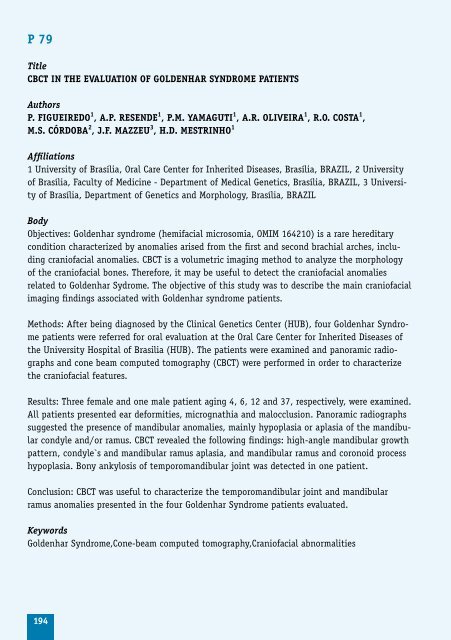Program including abstracts as pdf available here
Program including abstracts as pdf available here
Program including abstracts as pdf available here
You also want an ePaper? Increase the reach of your titles
YUMPU automatically turns print PDFs into web optimized ePapers that Google loves.
P 79<br />
Title<br />
CbCT IN THE EVALuATION OF GOLDENHAR SyNDROME PATIENTS<br />
Authors<br />
P. FIGuEIREDO 1 , A.P. RESENDE 1 , P.M. yAMAGuTI 1 , A.R. OLIVEIRA 1 , R.O. COSTA 1 ,<br />
M.S. CÓRDObA 2 , J.F. MAzzEu 3 , H.D. MESTRINHO 1<br />
Affiliations<br />
1 University of Br<strong>as</strong>ília, Oral Care Center for Inherited Dise<strong>as</strong>es, Br<strong>as</strong>ília, BRAZIL, 2 University<br />
of Br<strong>as</strong>ília, Faculty of Medicine - Department of Medical Genetics, Br<strong>as</strong>ília, BRAZIL, 3 University<br />
of Br<strong>as</strong>ília, Department of Genetics and Morphology, Br<strong>as</strong>ília, BRAZIL<br />
Body<br />
Objectives: Goldenhar syndrome (hemifacial microsomia, OMIM 164210) is a rare <strong>here</strong>ditary<br />
condition characterized by anomalies arised from the first and second brachial arches, <strong>including</strong><br />
craniofacial anomalies. CBCT is a volumetric imaging method to analyze the morphology<br />
of the craniofacial bones. T<strong>here</strong>fore, it may be useful to detect the craniofacial anomalies<br />
related to Goldenhar Sydrome. The objective of this study w<strong>as</strong> to describe the main craniofacial<br />
imaging findings <strong>as</strong>sociated with Goldenhar syndrome patients.<br />
Methods: After being diagnosed by the Clinical Genetics Center (HUB), four Goldenhar Syndrome<br />
patients were referred for oral evaluation at the Oral Care Center for Inherited Dise<strong>as</strong>es of<br />
the University Hospital of Br<strong>as</strong>ilia (HUB). The patients were examined and panoramic radiographs<br />
and cone beam computed tomography (CBCT) were performed in order to characterize<br />
the craniofacial features.<br />
Results: Three female and one male patient aging 4, 6, 12 and 37, respectively, were examined.<br />
All patients presented ear deformities, micrognathia and malocclusion. Panoramic radiographs<br />
suggested the presence of mandibular anomalies, mainly hypopl<strong>as</strong>ia or apl<strong>as</strong>ia of the mandibular<br />
condyle and/or ramus. CBCT revealed the following findings: high-angle mandibular growth<br />
pattern, condyle`s and mandibular ramus apl<strong>as</strong>ia, and mandibular ramus and coronoid process<br />
hypopl<strong>as</strong>ia. Bony ankylosis of temporomandibular joint w<strong>as</strong> detected in one patient.<br />
Conclusion: CBCT w<strong>as</strong> useful to characterize the temporomandibular joint and mandibular<br />
ramus anomalies presented in the four Goldenhar Syndrome patients evaluated.<br />
Keywords<br />
Goldenhar Syndrome,Cone-beam computed tomography,Craniofacial abnormalities<br />
194


